Translation revised by Michael S. Howard, Feb. 2012
During our researches on Minchiate, we have found at the Castiglion Fiorentino Library a document of extraordinary importance for the completeness of the explanation of the game and its rules (1). It concerns the manuscript Regole del nobile e dilettevole gioco delle Minchiate (Rules of the noble and pleasant game of Minchiate) written by the lawyer Niccolò Onesti (Rome, 1716) (2). The work, placed as insert 7 (of 9) in Ms. miscellaneous 550 (size cm. 77 x 20), comes from the house of Mr. Giuseppe Cagnoni, nephew and heir of the historian Guseppe Ghizzi. The Library also possesses a copy of this manuscript, contained in Ms. miscellaneous 185, produced by the same author and given to that Institution by the widow of the same historian in 1895 together with all the manuscripts belonging to her husband.
The exemplar of Ms. 550, whose sheets are very damaged, appears without doubt to be the rough draft, the bad copy we would say, full of corrections, and even writing put in the white spaces as notes. On the first page, above the title and under Prefazione (Preface), is written furono stampate in un libricciolo (they were printed in a small book); but the work immediately continues with the first chapter. Next to the title Sono composti dall'Avv° Abb. Niccolò Onesti in Roma autografo. (They are composed by the lawyer Abb. Niccolò Onesti in Rome autograph). In the last page, in the superior part we find the inscription Amico Lettore (Friend Reader) while in the inferior part is written l'Indice dei Capitoli (Index of the Chapters); to the left of the index, separated by a dividing line, the writing Frontespizio (Frontispiece) and under it, again separated by a line, Regole del nobile onesto e dilettevol gioco delle minchiate (Rules of the honest noble and pleasant game of Minchiate) after which follow various words for the most part deleted, among which Data in luce......ciascuno possa apprendere con siffatta maggior facilità di forme.........Anno 1716. (Given into the light...... every one could learn with such greater facility of forms.........Year 1716).
The good copy, preserved in the Ms. 185, simply reports the title Trattato del gioco delle Minchiate (Treatise on the game of Minchiate) (3) and it is in good condition. For the examination of the contents we will use therefore this exemplar (4).
The Treatise, written on 26 unnumbered pages (size cm. 16 1/2 x 23), is structured in eight chapters preceded by the following inscription to the Friend Reader:
Friend Reader
“Being convenient to everyone for relief from his applications is some honest and pleasant entertainment, and among these the game of Minchiate seems to be proper; for its curiosity and charm, and much more for its virtuous qualities, since it is a lively exercise of the good genius, of spirit, and talent, not less of attention and memory, as also of economy. Thence it has been judged well to gather its rules in this small book for the common benefit, rules judged as the more proper and general so that everyone could learn with more facility, and through the same means, with that modesty, enjoyment, and economy, that pertains regularly to the nature of this game, the hours of its convenient recreation. So, enjoy, you reader, this small effort and sympathize with it as well, if something is lacking, as it was done for the mind in a few hours, and Live Happy”.
The text presents a lot of underlines, with the purpose of attracting the reader’s attention. The length of the chapters varies, becoming longer starting with the third.
In the following we report the First Chapter, by which we are informed that the game consisted of 97 cards, of which 40 wereTarots and 56 were called Cartiglia cards. The Tarots were those marked with numbers beginning from one, called Ganellino (another name, used in the plural, for this game, with its variant Gallerini used in Liguria and Sicily) up to the number XXXV, which is the zodiacal sign of Gemini; then it continues with the so-called Airs, which are the Star, the Moon, the Sun, the World and finally the Trumpets. To these 40 Tarots was added the Fool, without number, set as the forty-first Tarot. The Cartiglia were composed of four kinds of cards, which are Cups, Coins, Swords and Batons, of which 10 were numeral cards and 4 were figures - page, knight, queen and king - for every suit, for a total of 56 cards, and these combined with the tarots reached the conspicuous number of 97 cards.
Reporting the First Chapter, we have maintained the punctuation and the underlining as they are in original, while the shortened words have been reported in full.
Chapter One
General explanation of the cards with which one plays Minchiate.
The deck of cards with which to play Minchiate consists of n° 97, forty-one of which are called Tarots and the other 56. are called La Cartiglia.
Tarots are those marked at the top of each card with the number; starting from the one that is called Ganellino until number XXXV, then follows in order the Star, which comes to be be 36. Then the Moon. 37. then the Sun. 38. the World 39. and finally the Trumpets which are number 40, and these five are called the Airs. Adding to the Tarots also the Fool which doesn’t have number and it is so called because it is various and mixes with all the cards and from them detaches absolutely as it will be said later, it is set for 41. Taroccho.
The Cartiglia is divided into 4 kinds; that is cups and coins = swords and batons; each of which consists in 14 cards, that is 10 of number near the same and 4 Figures, that is Page of swords and batons and Woman of cups and coins. Then Knight, then Queen, and then = King, in all 4. These said suits complete the aforesaid n° of 56 cards, which united to the aforesaid Tarots 41 give the aforesaid n° of 97 as we said.
These themes treated in the further chapters:
Chapter. 2°.
Explanation of the Quality and nature of the aforesaid cards and what each of them is counting.
Chapter. 3°.
Explanation of the verzicole. What are they? Of which kind? And how much do they count?
Chapter4°.
About the way and rule of starting the said Game of Minchiate and giving cards, with their right distribution to the four Players.
Chapter 5°.
About the way of playing this game after having made the aforesaid distribution of the cards to players.
Chapter. 6°.
About the way of counting and sign the discards that result and are won in the game after finishing each of them.
Chapter7°.
Explanation and information of some general rules, assumed necessary to be known for said Game.
Chapter 8°, and last
Information about other more particular rules to be known, to learn more easily the meaning of this Game, and to play it well.
The unabridged transcription of the manuscript, completed by our associate Girolamo Zorli, an expert on the history of card games, is reported in PDF at the end of the article. To all those actively interested in the game, we recommend consulting the transcription by Zorli at his web site directly, // http://www.tretre.it since it is annotated with numerous notes (5).
For the purpose of documention, we report here, as follows, the first and last page of the exemplar contained in Ms. 550, and in addition the three initial pages of Ms. 185, containing the dedication Friend Reader, the First Chapter and the beginning of the Second.
Ms. 550
FIRST PAGE
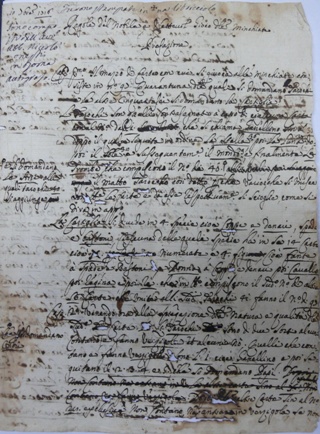
MS. 55o
LAST PAGE
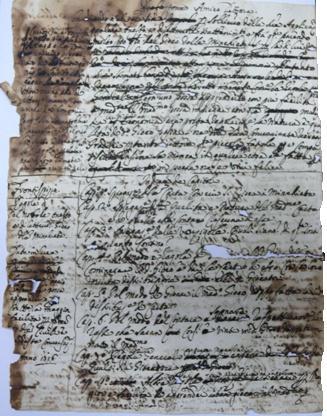
MS. 185
First Page
FRIEND READER
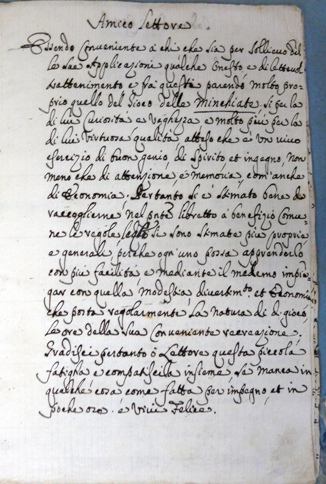
Ms. 185
Second page
BEGINNING OF CHAPTER ONE
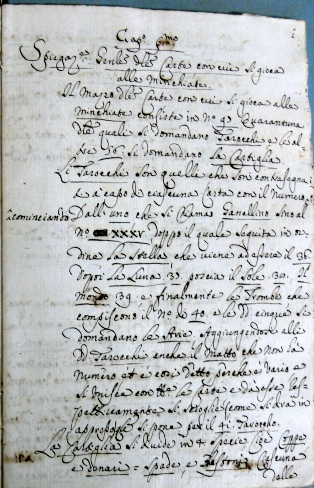
MS. 185
Third Page
END OF THE CHAPTER ONE - BEGINNING OF CHAPTER TWO
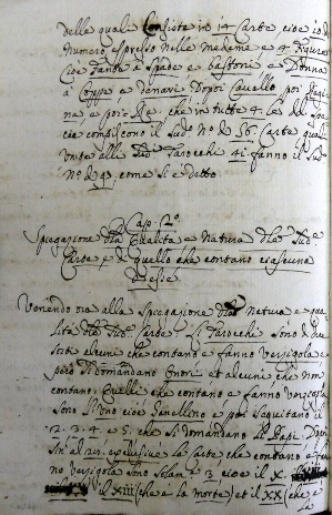
Complete transcription of the Trattato del gioco delle Minchiate - MS. 185 (pdf)
Notes
1 - While the oldest document about the game of Minchiate, unfortunately not exhaustive, is constituted by the commentary of Paolo Minucci, which appeared in the first edition of Il Malmantile Racquistato by Lorenzo Lippi published in 1676, a commentary later integrated by Antonio Maria Biscioni on the occasion of a new edition of the work (about this see the essay Il Malmantile Racquistato), the first known regulations of the game of Minchiate, before this discovery, were the untraceable Regolamento del nobilissimo gioco delle minchiate (Regulations of the very noble game of minchiate), by Raffaele Peveroni of 1727. The present Trattato is therefore the first testimony in order of time, and of great importance for its large amount of information. Including the attribution of the term Ganellino to the card of the Bagatto. At the site http://germini.altervista.org/ it is possible to learn the rules of the game reported in the text Regeln des Minchiatta-Spiels, Dresda, 1798, Waltherischen Hofbuchhandlunge and in the small volume Regole Generali del Nobilissimo Giuoco delle Minchiate (General Rules of the very noble Game of Minchiate), Rome, 1773, Capponi and Bartolomicchi.
2 - Niccolò Onesti was from Castiglion Fiorentino, member of the noble Family Onesti, and a lawyer in Rome in the XVIII century.
3 - About the meaning of the term Minchiata referring to the game, we have found a document of the first years of the XVI century that identifies it as "cosa sciocca" (foolish thing): "sminchiata voisi dir da sciocchi" (sminchiata means stuff for fools). See about that the article Farsa Satyra Morale.
4 - We want to thank the staff of the Castiglion Fiorentino Library for the precious information and exquisite helpfulness.
5 - See at the link http://www.tretre.it/menu/accademia-del-tre/testi-e-studi/regolamento-delle-minchiate-di-niccolo-onesti-dei-1716.html#c1438